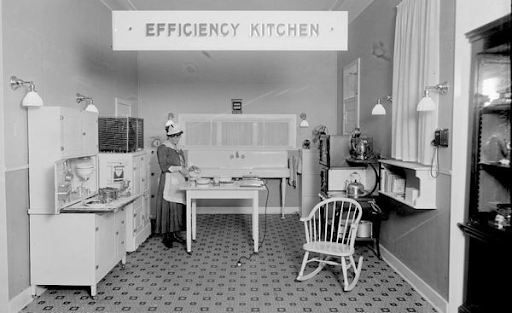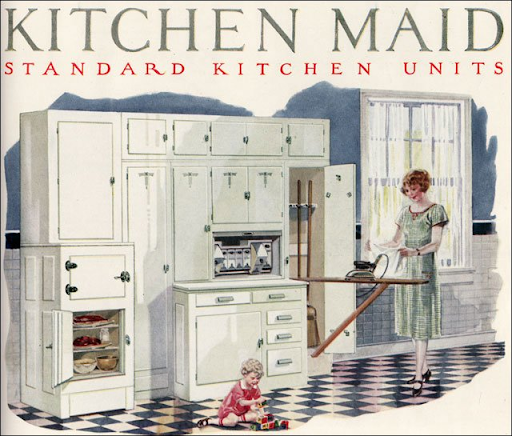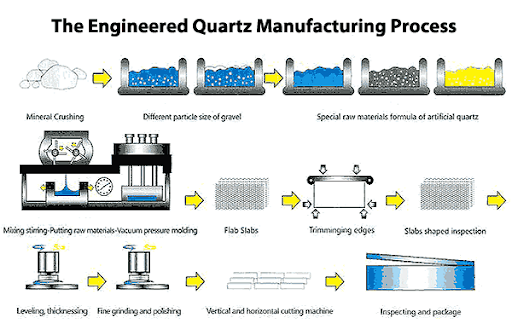One of the subjects that we get a lot of questions about is countertops, what kinds there are, how they are different, and what we recommend. Here's the 411:
When kitchens first took the leap of being an actual room as opposed to being the area around a fireplace hearth, countertops were made from either wood or stone, because that was what was available.
In the earliest days of kitchens, the pantry was in a separate location-- the kitchen was the room where the work was done only, and it was not intended for any other purpose. There may or may not have been running water, and the heating for cooking was primitive.

This kitchen shows a worktable and the piece that today we call a Hoosier cabinet. The Hoosier cabinet was used for baking preparation, and stored flour in a bin that dispensed it directly into a bowl, and usually had an enameled pullout countertop. These were all the countertop cooks had-- imagine having to make do with that now!
Fortunately, things have improved a great deal! After the wood and enameled countertops, there was Formica, which was commonly being used in kitchens by 1920. Also, in this same era, kitchen storage had moved more into the kitchen itself, along with cabinets. Kitchens became more a part of the design of a home, evolving into more of a family space, versus a room that was strictly utilitarian. From both of the older pictures featured here, it appears that white has always been a popular cabinet color, and it still is today!

Through the years, we have seen the arrival (and sometimes the departure) of lots of countertop materials. There has been butcher block (still around but less common) and tile, which we see used occasionally, but usually as a budget-saving attempt. Formica laminates are also still available, and are a less expensive choice, but with some definite drawbacks. It does not tolerate liquids well at the seams, and also can be chipped or cut pretty easily. Formica might be a good choice for a couple just starting out in their first home, and can be upgraded fairly easily in a few years. Corian came along in the 80's and is still available, but again, not used very often, as there are much more practical materials at the same price.
We offer Granite, Quartz, Marble, and Quartzite countertops. Let's look at what these are, and how they differ:
Granite
 Granite is a natural stone. It is mined and cut from the earth in huge blocks. Granite is an igneous rock. This means that it is volcanic in origin. Rather than flowing out of a volcano, granite forms underground when magma solidifies gradually without reaching the surface. Because it cools more slowly than erupted magma, it contains distinct and visible crystal patterns. Varied crystal sizes occur when the rock cools at different rates; faster cooling yields smaller crystal sizes. The various colors of granite are due to the differing proportions of minerals contained in the stone.
Granite is a natural stone. It is mined and cut from the earth in huge blocks. Granite is an igneous rock. This means that it is volcanic in origin. Rather than flowing out of a volcano, granite forms underground when magma solidifies gradually without reaching the surface. Because it cools more slowly than erupted magma, it contains distinct and visible crystal patterns. Varied crystal sizes occur when the rock cools at different rates; faster cooling yields smaller crystal sizes. The various colors of granite are due to the differing proportions of minerals contained in the stone.
Once mined, large blocks of granite are then further cut down into slabs, usually at the quarry, by giant saws, which have dozens of equally spaced parallel blades. The blocks are loaded into the saw and the entire block is cut into multiple slabs simultaneously-a process that may require 40 to 50 hours. Slabs are either 3/4 or 1 1/4 inches thick (2 or 3 cm). The slabs are bundled together to ensure that buyers can choose multiple slabs that are similar, because even within one type of granite there can be huge variations. There is a wide range of granite pricing, generally based upon availability/scarcity of the stone and the country of origin. Where the stone is quarried also affects the pricing. For example, blue-toned granite is said to come from deeper beneath the earth's surface, making it rarer and more costly. Granite countertops need to be sealed regularly, and are susceptible to stains.
Quartz
One of the reasons that Quartz is popular is that, being man made, it can be counted on to be more consistent in color and pattern from one piece to the next. Quartz countertops are formed by combining 90% ground quartz (a natural hard mineral) with 8-10% resins, polymers, and pigments. This forms a very hard granite-like surface. The appearance depends on how the quartz is ground: coarsely ground quartz produces a flecked appearance, while finely ground quartz produces a smooth look.
Quartz is very easy to live with, as it never needs sealing, is difficult to stain, and is very scratch resistant. You do need to be careful about placing hot pots and pans directly on quartz, as the resins cannot handle high temperatures; always use a trivet or hot pad. Quartz is slightly more expensive than granite.
Marble
 Marble has long been considered the top-of-the-line of countertops. It is beautiful, and more expensive than most granite. And it is also softer and more porous than granite & quartz. It stains and etches easily, and is best for two types of people: who barely cook or are totally manic about cleaning in the kitchen, or those who are relaxed and easygoing and see a stain or a mark as a memory, like that time Uncle Ernie spilled the bottle of red wine-- oh what fun!
Marble has long been considered the top-of-the-line of countertops. It is beautiful, and more expensive than most granite. And it is also softer and more porous than granite & quartz. It stains and etches easily, and is best for two types of people: who barely cook or are totally manic about cleaning in the kitchen, or those who are relaxed and easygoing and see a stain or a mark as a memory, like that time Uncle Ernie spilled the bottle of red wine-- oh what fun!
If any of these describe you- go for Marble- it gives the kitchen a look you just can't get anywhere else!
Quartzite
The last type of countertop we sell is Quartzite. Quartzite is a very hard metamorphic rock that originated as sandstone. Through a process of high heating and pressurization sandstone is transformed into Quartzite, an extremely strong and durable natural stone. When heated, individual quartz pieces recrystallize giving it a beautiful and decorative sparkling pattern. Quartzite is harder than granite and marble, but is still a natural stone that must be sealed. It is expensive, but gorgeous! It has some of the prettiest features of both granite and marble: the crystal-like, dimensional look of granites, and the colors and movement of marble. It really must be seen in person to appreciate its beauty!
It is impossible to say that one type of countertop is better than another. There are so many factors to consider- and we ask questions to try to help you decide which works best for you.
Come in and let us show you our gorgeous countertops!
And remember- if you are hoping to have a beautiful new kitchen to show off during the holidays, NOW is when you should do something about it! Nothing happens overnight, regardless of how it appears on HGTV. So, come on in and let's get started!
How Much Does It Cost?
Ball park price ranges for a medium sized kitchen, not including plumbing are:
Granite $3000 to $4000 installed
Quartz $4500 to $5000
Marble $4000 to $5500 installed
Quartzite $7000 to $8000 installed


No comments:
Post a Comment